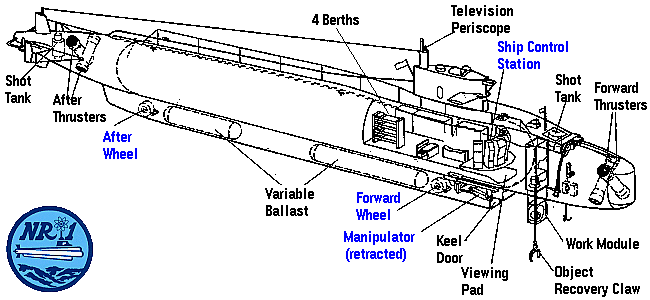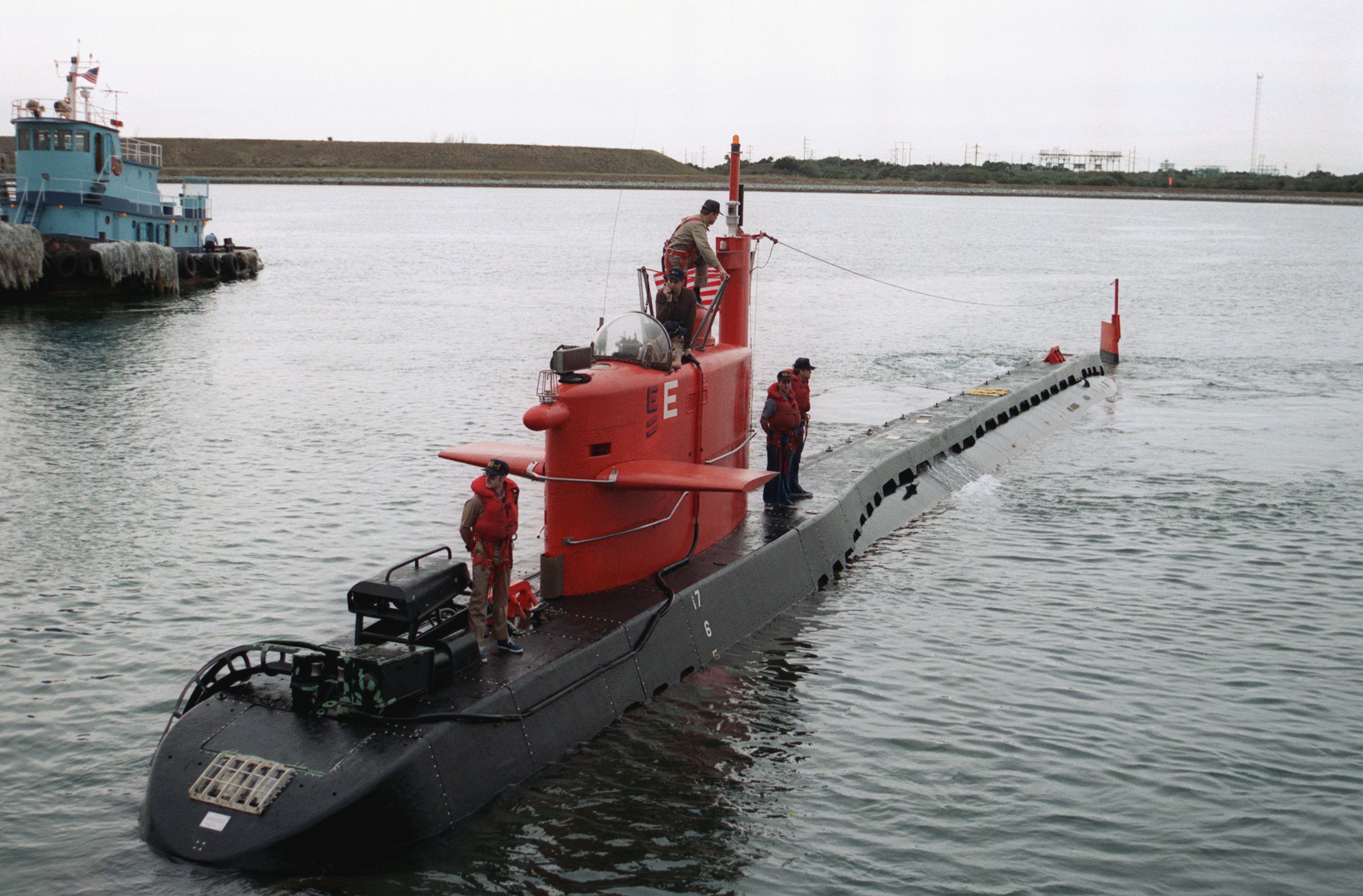By Ryan Faith
Every two years, the super scientists at the US Navy's Office of Naval Research host a symposium. There, they talk about grant applications and small business partnerships — but they also discuss the bleeding-edge future of naval warfare.
Amid all the talk of lasers, railguns, and firefighting robots, Dr. Robert Ballard, the man whose accomplishments include finding the Titanic and discovering previously unknown lifeforms near seafloor geothermal vents, gave a talk. A talk in which he casually mentioned a mind-blowing new concept: "terrain-involved submarine warfare."
That means putting wheels on subs.
Generally speaking, submarines really, really hate interacting with the seafloor. In fact, they spend much of their time trying desperately to avoid it. Hitting a sharp rock could (Poseidon forbid!) tear a hole in the hull, and that's a pretty bad thing when the sea is putting a half ton of pressure on every single square inch of it. Subs generally don't have windows, so parking one on the sea floor — which has no shortage of sharp rocks — would be an adventure. Worse yet, subs don't exactly stop on a dime; they have incredible amounts of inertia. Parallel parking would be a nightmare.
Navy bigwigs and eggheads are well aware of these facts. And yet Ballard told an auditorium full of them that Navy subs should get up close and intimate with the seafloor. What made him do such a thing? Once upon a time, Ballard was in the employ of Army intelligence, analyzing maps to figure out if ridges, hills, valleys, and whatnot could, for instance, hide enemy tanks or mask troop movements. Ballard subsequently moved over to the Navy, and based on his Army experience, he started advocating for the embrace of undersea terrain rather than its avoidance.
In 1984, Ballard demonstrated the ability to operate on the ocean floor during a two-week exploration near Iceland's Reykjanes Ridge. He took the Navy's deep-sea research submarine, the NR-1, down 3,000 feet and drove it around volcanic peaks; he even hid in the occasional lava tube. At the time, the NR-1 was the Navy's largest deep-sea research submarine and its smallest nuclear sub. At a length of 150 feet and 400 tons, it could support a crew of 13 for up to a month. But most importantly, the NR-1 had retractable wheels and portals. The wheels allowed the NR-1 to roll along the seafloor. The portals allowed the sub drivers to see where the hell they were going.
In addition to the fact that it's kind of badass to drive a submarine around on the ocean floor like a 400-ton, nuclear-powered tank, there are some definite advantages to rolling around in the mud. Submarines (and the surface ships they fight) rely on sonar to search for stuff. This can mean quietly listening for telltale sounds, like engine noises — that's called passive sonar. Or, like bats, subs can emit sound pulses, which bounce off objects, creating echoes that are received by the sub, a technique called active sonar. But in a complex, jumbled terrain with rocks, mountains, and canyons, the sound waves get so jumbled up that it's impossible to make any sense of the sounds that come back.
Navies also use very sensitive magnetic detectors to locate the giant, metallic mass of the submarine as it moves underwater. But this method is less effective in some kinds of seafloor terrain. For example, near basaltic rocks, which interfere with even simple compasses and create downright havoc with sensitive magnetic sub-hunting gear.
Between the jumbled sonar and the magnetic interference of the ocean floor, it can be very hard to find something hiding in the seafloor terrain. Ballard illustrated this point clearly when he dared the Navy to find him while he was tooling around on the Reykjanes Ridge in the NR-1. Two weeks of searching later, the Navy had no clue where he was.
The Navy lost interest in Ballard's display when the Cold War ended, but there are plenty of reasons why it deserves to be revisited. For decades, subs have relied on stealth to protect them. But as a report by the Center for Strategic and Budgetary Analysis notes, the old rules for subs may be changing. For starters, each incremental improvement in the technology that makes subs stealthier is getting exponentially more expensive, narrowing the performance gap between different submarines. In addition, there are a lot of sub-hunting techniques that circumvent traditional submarine stealth. Until now, those techniques required too much computational power to be practical. Soon, advances in computers may make these more exotic sensors a viable option.
That said, there's still one thing to keep in mind about Ballard's idea: how truly goddamn weird it is.
What he's proposing is a whole new war-fighting domain. Domain is wonkspeak for an environment in which fighting occurs, and up until 1,000 BCE or so, humanity fought in one domain: land. In the three millennia since, warfare has expanded into six — land, sea, undersea, air, space, and now cyberspace. For all practical purposes, the undersea domain today extends down a couple thousand feet or so (or to somewhere just above the seafloor if it's shallow enough). If you go deeper than that, it's aqua incognita for most subs; hulls collapse, death ensues, and nobody's happy.
But if you consider the undersea domain from the seafloor looking up rather than from the surface looking down, things start to change. Traditional submarines don't look like stealthy predators running invisible below the ocean waves — they look like big, fat, stupid blimps clumsily floating in the water above. New terrain-involved submarines become aquatic helicopters, landing and taking off from the seafloor. The most advanced seafloor mines, like the US Navy's CAPTOR — it's basically a torpedo that hides and listens for passing ships — become the seafloor equivalent of surface-to-air missile sites. Complex seafloor terrain is no longer a navigational hazard; it's a source of cover and concealment.
So really, this isn't about subs on wheels — it's about treating the ocean like the sky. And by doing that, everything anyone ever thought they knew about fighting in the sea and undersea domains is up for review.
None of this will happen anytime soon; current submarines don't go deep enough to interact with much of the sea floor. Smaller deep-submergence vessels capable of going several thousand feet down are slow, require a mothership, and generally can only operate for a few days at a time. But that will change; an explosion in ultra-deep sea oil drilling and the emerging field of seabed mining will continue to drive advances in Remotely Operated Vehicles (ROVs) and Autonomous Underwater Vehicles (AUVs). Terrain-involved submarines will be a reality.
And here's why all of this is truly creepy: Anything that makes subs easier to find and kill threatens nuclear missile subs. Nuclear ballistic missile submarines are considered the nuclear deterrent of last resort because they've historically been the most reliable and best protected part of the nuclear arsenal. Even if an attacker can hit every single square inch of a country in a surprise nuclear attack, the attacker would still be vulnerable to a devastating counterattack launched by nuclear subs hiding at sea. Because of this, the majority of the US nuclear arsenal is submarine-based. A guaranteed ability to counterattack goes a long way in preventing enemies from getting an itchy nuclear trigger finger.
But seafloor warfare could change that. Nations all around the world — including the US, Russia, and China — are signatories to the Seabed Arms Control Treaty that bans placing nukes on the seafloor (at least outside of the coastal zone that extends 12 miles from a country's shores). If a nation withdrew from the treaty to build a nuclear missile base on the seabed because it no longer felt its nuclear missile subs were secure, it could spark an arms race. Thus, seafloor warfare can threaten the stability of the nuclear deterrent. And if the idea of wheels on subs occurred to Ballard, it's no doubt occurred to other bright folks elsewhere in the world.
The thing about treaties is that they're not forever. Eventually, someone decides to quit or cheat, or technology advances so much that the treaty becomes a historical relic. The US withdrew from the Anti-Ballistic Missile Treaty in 2001 to pursue its missile defense program. In early March, Russia completed its de facto withdrawal from the Treaty on Conventional Armed Forces in Europe, which limits the size of armies deployed to Europe. So there's no reason to believe the existing treaty on WMD on the ocean floor will last forever. So Ballard's mind-blowing concept of today could be a real headache of tomorrow.
Follow Ryan Faith on Twitter: @Operation_Ryan
*Article publicat a Vice News. Interessantíssima informació per totes aquelles persones interessades en les operacions submarines. Certament, el contacte amb el fons sempre ha estat una espasa de doble fulla: una amenaça seriosa per la integritat del casc, però un mantell difuminador davant possibles caçadors. Per pensar-hi.


Cap comentari:
Publica un comentari a l'entrada